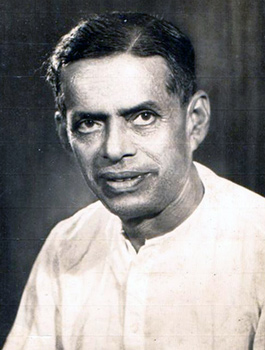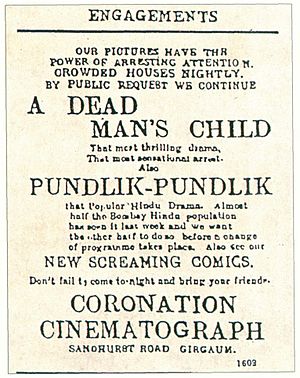Dadasaheb Torne facts for kids
Quick facts for kids
Dadasaheb Torane
|
|
|---|---|
 |
|
| Born |
Ramchandra Gopal "Dadasaheb" Torne
13 April 1890 Konkan coast, Mumbai.
|
| Died | 19 January 1960 (aged 69) |
| Nationality | |
| Occupation | Director, producer |
|
Notable work
|
Shree Pundalik, first feature film in India |
Ramchandra Gopal Torne (Marathi: रामचंद्र गोपाळ तोरणे) (born April 13, 1890 – died January 19, 1960) was an important Indian director and producer. He is famous for making Shree Pundalik, which was India's very first feature film. This amazing event was announced in an advertisement in The Times of India newspaper on May 25, 1912. Many well-known books about cinema agree that this was a huge step for Indian movies.
Even though Torne made his film Shree Pundalik in 1912, almost a year before Dhundiraj Govind "Dadasaheb" Phalke made Raja Harischandra in 1913, Phalke is often called the "Father of Indian cinema." This is because Torne sent his film overseas to be processed. Also, Torne's Pundalik was about 22 minutes long. Phalke's Raja Harischandra was longer, around 40 minutes.
Contents
About Dadasaheb Torne
Early Life
Ramchandra Gopal Torne was born on April 13, 1890. His birthplace was Malwan village, located on the western Indian Konkan coast near Mumbai. When he was young, his father passed away. This led to a difficult time for him and his mother. They had to leave their home and faced poverty.
At just 10 or 11 years old, Torne stopped school. He had only studied for four years. He then moved to Mumbai to find work. In Mumbai, he got a job at the Cotton Green Electrical Company. There, he learned how to install electrical systems and fix instruments.
His Film Journey
Making India's First Film
While working, Dadasaheb Torne met people from the Shripad theater company. He was very impressed by their plays. He also loved the new foreign films that were showing in Mumbai. As a young man of 21 or 22, he became very interested in making his own movie.
With a friend and supporter named Mr. Chitre, he bought film and a movie camera from another country. They used these to shoot Shree Pundalik. This was India's first feature film. It was shown on May 18, 1912, at the Coronation movie theater in Mumbai. Almost a year later, Dadasaheb Phalke released India's second feature film, Raja Harischandra, in the same theater. This happened on May 3, 1913. Pundalik played in the Mumbai theater for about two weeks. The newspaper advertisements for the film were very exciting. They said things like, "Half of Mumbai has seen it, the other half should see it too!"
Pundalik was filmed like a play. The camera was very heavy and stayed in one spot. This meant they could only record the movie from one angle. There was no way to edit scenes or do close-up shots back then. After watching his first recorded movie, Dadasaheb wasn't fully happy. He decided to record films in smaller parts. Then, he would join these parts together. This is what film editors do today. Dadasaheb was a true pioneer. He worked as a director, special effects person, and editor. He also handled sound recording and many other jobs. These are all common in movie-making today.
Starting a Film Business
When Shree Pundalik was released, Dadasaheb Torne was working at Greaves Cotton company. He was later moved to Karachi. There, he met a young man named Baburao Pai. Together, they started showing Hollywood movies in Karachi. To do this, he opened offices in Karachi and other cities. He was the first Indian to open movie distribution offices. He also started a movie distribution company.
Over the next few years, he worked with Baburao Painter in Kolhapur. After returning to Mumbai, he started his own "Movie Camera Company." Because of the First World War in Europe, he made connections in the United States. He began importing all the important equipment for the movie industry. This included cameras and film. His company became very helpful for filmmakers at that time. It quickly became well-known. All his hard work helped many new movie companies start up. Around 1929, he and Baburao Pai started a company called "Famous Pictures." This movie distribution company made a lot of money. It was successful from the time of silent movies to the first "talkies" (movies with sound).
Working with Ardeshir Irani
Famous Pictures began importing Hollywood movies, including some talkies. This was a big change for the film industry. Dadasaheb Torne understood how important talkies were becoming. He bought the rights to sell talkie-making machines. With help from Americans, he learned how to use this new technology.
A few years earlier, he had met Ardeshir Irani in Mumbai. Torne advised Irani to start his own studio, which became the famous Jyoti Studio. He also suggested Irani start a film production company, The Imperial Film Company. Irani hired Dadasaheb as a manager for both. Later, Dadasaheb advised Irani to create another company, Sagar Film Company. Around this time, Dadasaheb directed two silent films: Sindabad the Sailor (1930) and Dilbar (1931).
Next, he again told Irani that they should make a talkie. They had all the machines needed for it. They also taught the technicians at Imperial Company how to use them. The work on Alam Ara was kept a secret. In just two months, history was made! On March 14, 1931, India's first talkie, Alam Ara, was released. It played at the Majestic Cinema Theater.
People loved Alam Ara. After its success, Dadasaheb quickly supplied the new machinery to other studios. These included Prabhat, Ranajit, and Wadia studios. Soon, these studios started making new talkies. The era of silent movies was ending. The film world was completely different now.
Later Productions
Dadasaheb decided to start his own company. He wanted to work independently. In Pune, he formed Saraswati Cinetone (सरस्वती सिनेटोन). The company's first movie was Sham Sundar. This film became legendary. It was the first Indian film to celebrate a Silver Jubilee, meaning it ran successfully for 25 weeks. It also introduced two young actors, Shahu Modak and Shanta Apte. Famous sound recordist Chintamanrao Modak and music director Baapurao Ketkar started their careers with this movie.
The company's second movie was Aout Ghatakecha Raja. This film introduced Master Viththal as a director. He later became known as "Indian Douglas." This movie also had the first double role in Indian cinema.
The third movie was Bhakta Pralhaad. This film was famous for its many trick photography effects. Dadasaheb used his skills to create amazing optical illusions. Both Indian and foreign experts praised these special effects. He was a pioneer in many ways. He brought many "firsts" to the film industry. He also helped many talented artists get their start. These included Mehboob Khan (who started Mehboob Studio), Kardar, Bhalaji Pendharkar, Vishram Bedekar, C. Ramchandra, and Jayashree. Even Alam Ara's heroine, Zubeida, was first introduced by him.
He made many more movies later. Some of them were Thaksen Rajputra, Chhatrapati Sambhaji, Krishnashishtai, Savitri, and Raja Gopichand. In total, he made 17 movies: three in Hindi, eight in Marathi, and six that were in both Hindi and Marathi. He also produced a documentary film called Akshar-Olakh. This film was made to help spread literacy, not just for fun or money. The last movie from Saraswati Cinetone was Aawaj, released on May 22, 1942.
Final Years
Sadly, most of these old movies and their only copies were destroyed. Dadasaheb had built a studio in Pune. This studio was later sold. Today, a shopping mall stands where it once was. In 1947, while Dadasaheb was away, a person he knew and trusted took all his movie cameras and expensive equipment. This event deeply upset him. He had his first heart attack in 1947. His mother helped him through this difficult time. After such a big loss, his career in the film industry ended. The industry itself was also changing very quickly.
The success of his movie Shamsundar had given him enough money to live comfortably. He lived in his house called "Chandrika" in Shivajinagar. He named the house after his mother. He passed away peacefully in his sleep on the morning of January 19, 1960.
His Films
| No. | Name of production | Year | Language | What he did |
|---|---|---|---|---|
| 1 | Pundalik | 1912 | Silent | Producer / Director |
| 2 | Sati ka Shaap (Curse of Sati) | 1923 | Silent | Assistant Producer |
| 3 | Prithvivallabh | 1924 | Silent | Assistant Producer |
| 4 | Neera | 1926 | Silent | Assistant Director |
| 5 | Sindabad Khalasi (Sindabad the Sailor) | 1930 | Silent | Story/Director |
| Talkies (Movies with Sound) | ||||
| 6 | Shamsundar | 1932 | Hindi/Marathi | Producer / Sound Recordist |
| 7 | Aout Ghatakecha Raja | 1933 | Marathi | Producer / Sound Recordist |
| Aawara Shahjada | 1933 | Hindi | Producer / Sound Recordist | |
| 8 | Bhakta Pralhad | 1933 | Hindi/Marathi | Producer / Manager /Sound Recordist |
| 9 | Chhatrapati Sambhaji | 1934 | Marathi | Producer |
| 10 | Thakasen Rajputra | 1934 | Marathi | Producer / Director |
| Bhedi Rajkumar | 1934 | Hindi | Producer / Director | |
| 11 | Krishna-Shishtai (Krishna's Negotiations) | 1935 | Hindi | Producer |
| 12 | Savitri | 1936 | Marathi | Producer / Sound Recordist |
| 13 | Raja Gopichand | 1938 | Hindi/Marathi | Producer / Editor |
| 14 | Sach Hai' | 1939 | Hindi | Producer |
| 15 | Bhagwa Zenda | 1939 | Marathi | Producer |
| 16 | Mazi Ladaki (My Beloved) | 1939 | Marathi | Producer / Director |
| 17 | Devayani | 1940 | Marathi | Producer |
| 18 | Narad-Naradi | 1941 | Marathi | Producer / Director |
| 19 | Navardev (Bridegroom) | 1941 | Marathi | Producer / Director |
| 20 | Aawaj (Sound) | 1942 | Hindi | Producer |


